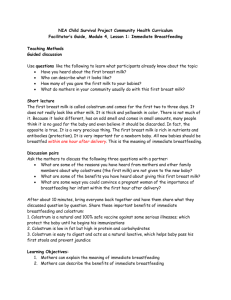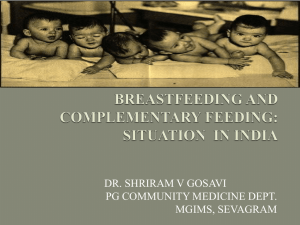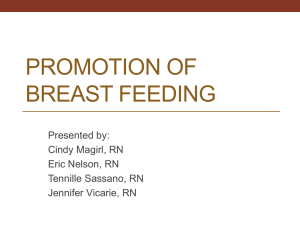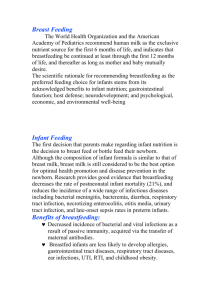Knowledge and practices of breastfeeding among ante
advertisement
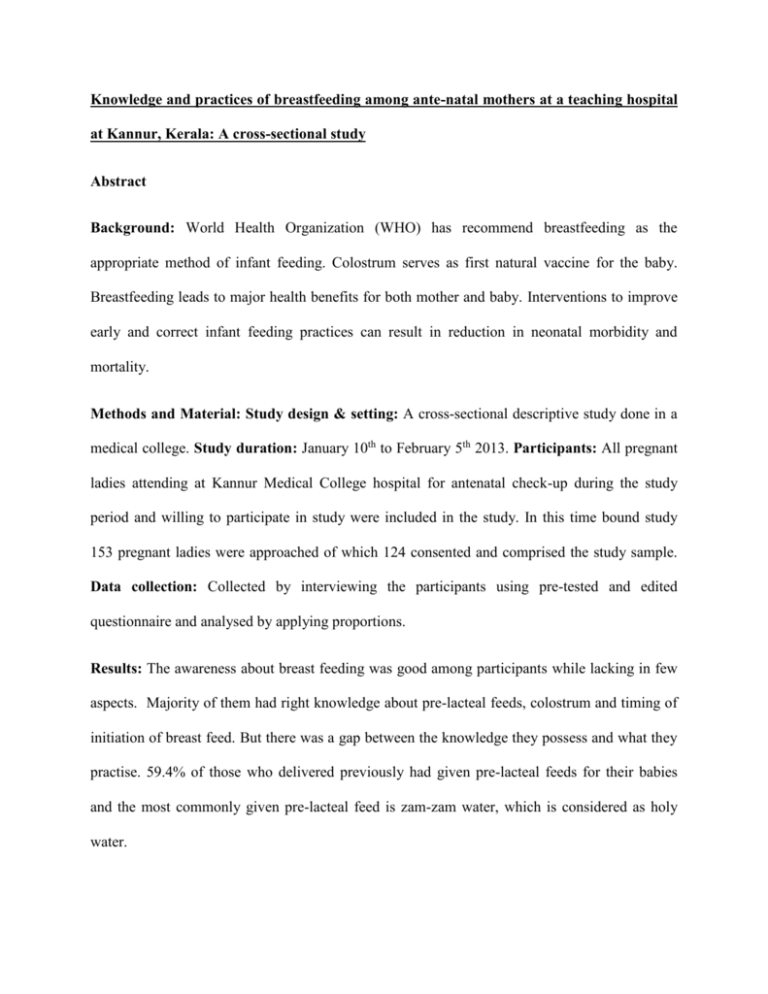
Knowledge and practices of breastfeeding among ante-natal mothers at a teaching hospital at Kannur, Kerala: A cross-sectional study Abstract Background: World Health Organization (WHO) has recommend breastfeeding as the appropriate method of infant feeding. Colostrum serves as first natural vaccine for the baby. Breastfeeding leads to major health benefits for both mother and baby. Interventions to improve early and correct infant feeding practices can result in reduction in neonatal morbidity and mortality. Methods and Material: Study design & setting: A cross-sectional descriptive study done in a medical college. Study duration: January 10th to February 5th 2013. Participants: All pregnant ladies attending at Kannur Medical College hospital for antenatal check-up during the study period and willing to participate in study were included in the study. In this time bound study 153 pregnant ladies were approached of which 124 consented and comprised the study sample. Data collection: Collected by interviewing the participants using pre-tested and edited questionnaire and analysed by applying proportions. Results: The awareness about breast feeding was good among participants while lacking in few aspects. Majority of them had right knowledge about pre-lacteal feeds, colostrum and timing of initiation of breast feed. But there was a gap between the knowledge they possess and what they practise. 59.4% of those who delivered previously had given pre-lacteal feeds for their babies and the most commonly given pre-lacteal feed is zam-zam water, which is considered as holy water. Conclusion: There is gap between the knowledge and what they practise. There is need to address the family members also about breastfeeding so that some of the hurdles in practicing correct breast feeding can be overcome. Key words: Breast milk, Breast feeding, Pre-lacteal feeds Introduction Mother’s milk is the most complete food available in nature for the baby. (1) The colostrum serves as first natural vaccine as it contains all the nutrients in definite proportions, easily digestible and assimilable.(1) Research evidence suggests that breastfeeding leads to major health benefits for both mother and baby.(2) World Health Organization (WHO) has recommend breastfeeding as the appropriate method of infant feeding. The advantages of breastfeeding are well documented.(3) Simple practice of correct breast feeding have proven to be life saving. Breast feeding promotion is a significant child survival strategy. Interventions to improve early and correct infant feeding practices can result in reduction in neonatal morbidity and mortality. (1) Most under-five deaths in developing country like India can be prevented by early initiation of breastfeeding and exclusive breastfeeding up to 6 months of age.(4) World Health Organization recommendation for breastfeeding is that all infants should be exclusively breastfed for the first six months of life, and receive nutritionally adequate and safe complementary foods while breastfeeding continues for up to two years of age or beyond.(5) Globally less than 40% of infants under the age of six months are exclusively breastfed.(4) World Health Organization says that, while breastfeeding is a natural act, it is also a learned behaviour.(5) In the world's more affluent societies, breastfeeding appears to have become a lost art and the feeding bottle has usurped the breast.(6) Breastfeeding decisions and practices are influenced by multiple factors including knowledge, attitudes and beliefs, as well as socio-cultural and physiological factors. It is important to have a good understanding of mothers' knowledge of the current recommendation on breastfeeding and their intention to meet the breastfeeding recommendation.(7) Antenatal period being the preparation phase for mothers for child care, the knowledge and practices regarding breast feeding among these ladies was assessed. Objective To assess the knowledge and practices of breastfeeding among ante-natal mothers attending Kannur Medical College Hospital. Methodology: Study design & setting: This cross sectional descriptive study was conducted at Kannur Medical College, Kannur, North Kerala from January 10th to February 5th 2013. Study participants: The study participants were those ante-natal mothers who came for ante-natal check-up at KMC during the study period and willing to participate in the study. During this time bound study, totally 153 mothers were approached among whom 124 consented for the study who comprised to be our study sample. Data collection: During their waiting period at hospital, mothers were contacted and briefed about the study and motivated to participate in the study. Those ladies who consented to participate were interviewed at a comfortable and convenient place by using a pre-tested and validated semi-structured questionnaire containing various aspects of breast feeding. Ethical clearance: The study was approved by Institutional Ethical Committee of Kannur Medical College, Anjarakandy Statistical analysis: After collection of data, information gathered was entered into Microsoft excel 2007 version & analyzed by using Percentage/proportions and presented in suitable tabular and graphical forms. Results: A of total 124 antenatal mothers were interviewed during the study period, majority of them were below the age of 25 years. The mean age of the participants was 27.3 years. 96% of the women were literate. 77.4% of them had previously delivered a baby. 22.6% have become pregnant for the first time. (Table: 1) When assessed about the knowledge about different aspects of breastfeeding, 59.6 % of them were aware that pre-lacteal feeds should not be given to the babies. 93.5% opined that colostrum is good and be given to the babies. 79% and 25.8% of them were aware about the timings of initiation of breast milk after vaginal and caesarean delivery respectively. 45.1% had knowledge about the concept of demand feeding. 82.2% and 77.4% of them knew about the duration of exclusive and continued breast feeding respectively. 65.3% were aware that breast milk should be continued even during the period of illness. 78.2 % of them were of the opinion that bottle feeding and artificial teats should not be given to the baby. (Table: 2) Among those who had delivered previously; assessment about the practices followed in relation to breast feeding in previous pregnancies showed that there was a discordance in the knowledge level and the practises which reflects the gap in converting the knowledge into practice. (Table 2) 30.64 % of ladies were aware of giving expressed breast milk to baby when separation is inevitable. 41.1% preferred to give formula feeds, 15.3 % and 12.96% opined of considering undiluted cow’s milk and diluted cow’s milk respectively. (Table 3) Among those 96 mothers who had previously delivered the baby; 40.6% of them didn’t give any pre-lacteal feeds in their previous delivery. While the most commonly given pre-lacteal feed practiced in their locality were Zam-Zam water (holy water) (35.4%), honey (13.5%) and sugar syrup (11.04%). (Fig 1) Half of the women expressed that the main source for their knowledge about breastfeeding was given by mother/mother in law. Health professionals and media also contribution was 25.8% and 17% respectively. (Figure 2) Discussion: The promotion and support of breastfeeding is a global priority and an important childsurvival intervention. Some of the problems of breast feeding can be overcome if the woman is informed ante-natally about the benefits of breastfeeding and prepared mentally for exclusive breastfeeding.(8) In our study, 59.6 % of respondents were aware that pre-lacteal feeds should not be given to the babies in contrast to study done by Ekambaram M et al(9) and Kulkarni J(10) which reported higher level of awareness. 93.5% opined that colostrum is good and be given to the babies similar observations were seen in study done at Indore(10) while a better response was observed in Nepal.(11) 79% of our study participants were aware that breast milk should be given immediately after vaginal delivery which was better compared to report by Joshi SK (11) and Chaudhary RN.(12) 25.8% of them were aware about the timings of initiation of breast milk after ceserean delivery while study done by Ekambaram(9) reports higher rates. 82.2% and 77.4% of them knew about the duration of exclusive and continued breast feeding respectively which was better when compared to observations done by Chaudhary RN(12) and non-counselled group in study done by Dhandapany(8). The most commonly practised pre-lacteal feed was zam-zam water, considered to be holy water which is a practice prevalent in this part of Kerala, which needs to be addressed. Relatives play a major role in influencing the knowledge and in-turn practise of breast feeding. Only a little proportion of participants had realised that breast feeding benefits both mother and baby. Impressing upon this fact may help in encouraging the practice among the mothers. Majority of our participants opted for formula feeds when separation from baby was inevitable in contrast in study done by Ekambaram(9) which shows 51% had knowledge about expressed milk. It is also observed in our study that the higher level of awareness was not totally converted into practice which hints that even though it’s widely understood that the level of knowledge determines the practice, there are still some factors that hinders from full translation of knowledge into practise Conclusion In our study it was found that the awareness among ante-natal mothers about breastfeeding is good in most of the components excepting few. The good level of awareness might be because of the high proportion of the female literacy level in Kerala. A considerable gap exists between the knowledge and the practice in breast feeding. Pregnant mothers should be impressed that breast feeding benefits not only the babies but also them and their family in turn. There is need to address issues of breastfeeding among the relatives of pregnant so that even which may sometimes act as hurdle in bringing into action the things that are known. Acknowledgement We would like to express our gratitude to all the study participants helped us to successfully complete our study. References 1. Suryakantha AH. Community Medicine with recent advances. 3nd ed. New Delhi: Jaypee Publishers; 2013. 2. Health and social wellbeing: young mothers & breastfeeding rates. [online]. [cited 2013 Oct 12]. Available from: URL: http://www.dhsspsni.gov.uk/breasfeedingratesyoungmothers.pdf 3. Foo LL, Quek SJS, Ng SA, Lim MT, Deurenberg M. Health Promotion International 2005 Apr; 20 (3): 229-237. 4. Shetty SB, Shetty SK. KAP study of factors promoting breastfeeding in nursing mothers and pregnant women. Nitte University Journal of Health Science 2013 Sept; 3 (3); 34-37. 5. World Health Organisation. Nutrition: Exclusive breastfeeding. [online]. [cited 2013 Oct 12]. Available from: URL: http://www.who.int/nutrition/topics/exclusive_breastfeeding/en/ 6. Park K. Park’s Textbook of Preventive and Social Medicine. 22nd ed. Jabalpur: Banarsidas Bhanot Publishers; Feb 2011. 7. Wen LM, Baur LA, Rissel C, Alperstein G, Simpson JM. Intention to breastfeed and awareness of health recommendations: findings from first-time mothers in southwest Sydney, Australia. Int Breastfeeding Journal 2009;4:9 doi:10.1186/1746-4358-4-9. 8. Dhandapany G, Bethou A, Arunagirinathan A, Ananthakrishnan S. Antenatal counseling on breastfeeding – is it adequate A descriptive study from Pondicherry, India. Int Breastfeeding Journal 2008;3:5 doi:10.1186/1746-4358-3. 9. Ekambaram M, Bhat VB, Ahamed. MAP. Knowledge, attitude and practice of breastfeeding among postnatal mothers. Curr Pediatr Res 2010; 14 (2): 119-124. 10. Kulkarni J, Rekahde N, Sharma S. Knowledge and practice of mothers about breast feeding. [online]. [cited 2013 Oct 12]. Available from: URL: http://www.ssmrae.com/admin/images/0a0b27357895a5b82567fcabc36c0850.pdf 11. Joshi S, Barakoti B, Lamsal S. Colostrum Feeding: Knowledge, Attitude and Practice in Pregnant Women in a Teaching Hospital in Nepal . WebmedCentral:International Journal of Medicine and Molecular Medicine 2012;3(8):WMC003601 12. Chaudhary RN, Shah T, Raja S. Knowledge and practice of mothers regarding breast feeding: a hospital based study. Health Renaissance, 2011;Vol 9 (No.3);194-200. Tables Table 1: Basic background information about participants Variable Variable categories Number (%) N=124 Age (Years) Education status 18 – 25 86 (69.4) 26 – 35 32 (25.8) > 35 6 (4..8) Illiterate 5 (4) Literate 119 ( 96) Order of pregnancy First 28 (22.6) second 72 (58.1) Third and above 24 (19.3) Table 2: knowledge and practices of breast feeding Correct Knowledge Correct practise in previous pregnancies Factor N= 124 N= 96 Number (%) Number (%) About pre-lacteal feeds 74 (59.6) 39 (40.6) About colostrum feeding 116 (93.5) 68 (70.8) Time of initiation of Breast feeding After normal delivery 98 (79) 34 (35.41) After caesarean section 32 (25.8) 15 (15.6) About demand feeding 56 (45.1) 39 (40.6) Duration of Exclusive breastfeeding 102 (82.2) 50 (52.08) Duration of continued breast feeding 96 (77.4) 27 (28.1) Continuation of breast feeding during 81 (65.3) 58 (60.4) illness About bottle feeding and Artificial teats 97 (78.2) and pacifiers 62 (64.6) Table 3: knowledge about feeding the baby when separation from baby is inevitable Feeding options when No. of responses Percentage separated from baby Expressed milk 38 30.64 Formula feed 51 41.1 Undiluted cow’s milk 19 15.3 Diluted cow’s milk 16 12.96 Total 124 100 Fig 1: Practice of pre-lacteal feeds among previously delivered mothers (N=96) Fig 2: Sources of knowledge about breast feeding


